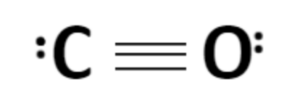Table of Contents
Carbon Monoxide Formula
Carbon monoxide (CO) is a colourless, odourless, and toxic gas. It consists of one carbon atom bonded to one oxygen atom. It is produced by incomplete combustion of carbon-containing fuels, such as gasoline, natural gas, coal, and wood. Carbon monoxide is highly dangerous because it binds to hemoglobin in red blood cells, reducing their ability to transport oxygen to body tissues.
Exposure to high levels of carbon monoxide can lead to carbon monoxide poisoning, which can be life-threatening. Symptoms of carbon monoxide poisoning include headache, dizziness, nausea, confusion, and in severe cases, loss of consciousness and death.
Due to its toxic nature, carbon monoxide is a significant concern in residential and industrial settings. It is crucial to have proper ventilation and functioning carbon monoxide detectors in areas where fuel-burning appliances are used, such as homes, garages, and workplaces, to prevent the buildup of this dangerous gas.
Carbon monoxide is also a significant environmental pollutant, contributing to air pollution and climate change. It is released by vehicle exhaust, industrial processes, and wildfires. Measures are taken to reduce carbon monoxide emissions and ensure the safety and well-being of individuals and the environment.
Carbon monoxide structural formula:

| Formula | CO |
| Molar Mass | 28.01 g/mol |
| Density | 1.14 kg/m³ |
| Melting Point | -205 °C |
| Boiling Point | -191.5 °C |
Solved examples on Carbon monoxide formula
Example 1: Combustion Reaction Carbon monoxide (CO) reacts with oxygen (O2) to produce carbon dioxide (CO2). If 5 moles of carbon monoxide react completely, how many moles of carbon dioxide will be formed?
The balanced chemical equation for the combustion of carbon monoxide is:
2CO + O2 → 2CO2
According to the stoichiometry of the balanced equation, 2 moles of carbon monoxide produce 2 moles of carbon dioxide.
So, for 5 moles of carbon monoxide:
Moles of carbon dioxide = (Moles of carbon monoxide × Moles of carbon dioxide produced per mole of carbon monoxide)
Moles of carbon dioxide = (5 moles × 2 moles of carbon dioxide per mole of carbon monoxide)
Moles of carbon dioxide = 10 moles
Therefore, when 5 moles of carbon monoxide react completely, 10 moles of carbon dioxide will be formed.
Example 2: Calculation of Molar Mass Calculate the molar mass of carbon monoxide (CO).
The molar mass of carbon is 12.01 g/mol, and the molar mass of oxygen is 16.00 g/mol.
To calculate the molar mass of carbon monoxide (CO), we add the molar masses of carbon and oxygen.
Molar Mass = (Number of carbon atoms × Molar mass of carbon) + (Number of oxygen atoms × Molar mass of oxygen)
Molar Mass = (1 × 12.01 g/mol) + (1 × 16.00 g/mol)
Molar Mass = 12.01 g/mol + 16.00 g/mol
Molar Mass = 28.01 g/mol
Therefore, the molar mass of carbon monoxide (CO) is 28.01 g/mol.
Frequently Asked Questions on Carbon Monoxide Formula
What is the difference between CO and CO2?
CO represents carbon monoxide with one oxygen atom, while CO2 represents carbon dioxide with two oxygen atoms. CO is toxic, whereas CO2 is naturally present in the atmosphere.
Why the formula of carbon monoxide is CO?
The formula of carbon monoxide is CO as it consists of one carbon atom and one oxygen atom, forming a compound with a 1:1 ratio.
Why the formula of carbon monoxide is CO?
The formula reflects the molecular composition; one atom of carbon and one atom of oxygen combine to form carbon monoxide, hence CO.
What is carbon monoxide?
Carbon monoxide is a colorless, odorless, and toxic gas produced during incomplete combustion of carbon-containing materials.
How is carbon monoxide harmful?
Carbon monoxide is harmful as it binds to hemoglobin in blood more tightly than oxygen, reducing the oxygen-carrying capacity of blood, which can be lethal.
What are the symptoms of carbon monoxide poisoning?
Symptoms include headache, dizziness, weakness, nausea, vomiting, chest pain, confusion, and in severe cases, it can lead to death.
How can I protect myself from carbon monoxide poisoning?
Ensure proper ventilation, maintain appliances, install carbon monoxide detectors, and have regular inspections to prevent carbon monoxide poisoning.
What should I do if I suspect carbon monoxide poisoning?
If suspected, move to fresh air immediately, call emergency services, and do not re-enter the area until it's deemed safe by professionals.
Can I smell or see carbon monoxide?
No, carbon monoxide is colorless and odorless, making it extremely dangerous as it's impossible to detect without a proper carbon monoxide detector.






